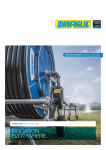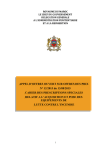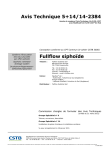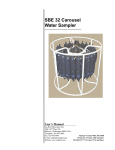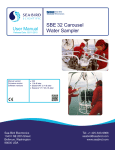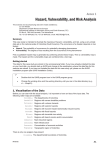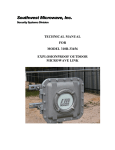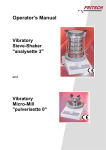Download INSTALLATION MANUAL 1-866-LIFT NOW
Transcript
INSTALLATION MANUAL 1-866-LIFT NOW Sizing/Measurements - External - Internal - Capacity Transom Installation - Alignment - Thru Holes - Mounting - External / Internal Fastening - Load Distribution Hydraulic Power Unit (HPU) - Location Selection - Mounting - Hydraulic Lines - 12 Volt Power (24V Optional) Initial Operation - Power Down - Power Up - Fluid Level Check Final Certification - Lift Arms & Receiver - Installation - Adjustment Protection - Anti-Fouling Paint - Fluid Level - Annual Inspection Hardware Kit Contents Owner Introduction - System Overview - Operation - Questions / Comments 1-866-LIFT NOW or 1-616-784-8759 - [email protected] Determining Sizing & Measurements The FreedomLift ® can be mounted on virtually all inboard powered boats by determining the following measurements: External Measurement Requirements - - Distance from the bottom of the swim platform to the bottom of the transom generally at or near the prop shafts – a minimum vertical distance of 23 inches is required for installation. (Call us for Models requiring less space) Distance from the water line to the bottom of the swim platform. Distance from the transom (under the swim platform) to the end of the swim platform (at approximately the prop shafts). Anticipated distance between the inside of the back plates (these plates measure 10” wide). Swim platform “thickness” from the bottom to the top of the platform. Internal Measurement Requirements - Based upon the anticipated external mounting location, verify that there is sufficient access for the mounting plates & bolts inside the boat. Be sure that stringers will not hinder thru bolts. Allow adequate room for backing plates, nuts, hydraulic fittings and hoses, stringer tie and Hydraulic Power Unit mounting location. Review anticipated mounting location for Hydraulic Power Unit verifying distance to transom, ability to mount, 12-volt (24 volt optional) DC access and serviceability (i.e. checking fluid level). Capacity Note the FreedomLift ® is rated to carry a maximum weight of 800 lbs. in normal conditions. The recommended capacity for your particular boat may be limited to the capacity of the transom. For transom capacity information please consult your boat manufacturer. Once determined, NEVER exceed this capacity. Transom Installation Step 1 – Connecting Spreader Bar Unpack FreedomLift ® equipment Fasten the Spreader Bar between the two Lift Assemblies utilizing the Stainless Steel Spreader Bolts ½” (4 or 8 per side depending on model) with red Loctite Threadlocker. Step 2 – Drill Mounting Holes Utilizing boat jack stands or other capable supporting devices, align the FreedomLift ® to the selected mounting location. Verify the following: - Mounting plates do not extend below the hull. The thru bolts have adequate internal and external clearance. Lift will operate unhindered by the swim platform, boat hull, trim tabs, or other transom accessories. Once the mounting location is verified, select six holes on each mounting plate (3 on the inside and 3 on the outside) to attach the FreedomLift ®. Note - the top bolts MUST BE in the top holes and the bottom holes should be as low as possible preferring location 5 or location 4. A minimum of 6 bolts must be used for securing each mounting plate – 2 on top, 2 in the middle and 2 towards the bottom. Additional mounting bolts may be used if desired. The Fluid Passing Bolts must NEVER be used in the top holes. With the FreedomLift ® against the transom, drill (6) ½” holes (per hydraulic side) in perpendicular alignment through mounting plates and transom. Step 3 - Mounting Remove any anti-fouling paint from the transom where the FreedomLift ® will mount plus 1” in addition to the FreedomLift ® footprint. This assures that the FreedomLift is not electrically bonded to the boat through the bottom paint which often contains copper. Mount the FreedomLift ® to the transom and LOOSELY tighten the mounting bolts. Use 3M 5200 to seal the bolts on the inside of the boat and outside at the FreedomLift plate. Insert bolts with external washer through the top bolt holes. Be sure there is adequate 3M 5200 to assure a watertight seal. Fit internal top plates on the inside of transom and add washer, lock washer and nut. Snug tighten. NOTE THAT EACH SIDE OF THE FREEDOMLIFT MUST BE PARALLEL TO EACH OTHER. ONLY SNUG TIGHTEN AT THIS TIME. Fluid Passing Bolts – Prior to installing, be sure the hole bore through the bolt is covered to prevent ANY internal contamination with the 3M 5200. Use a sufficient grade of tape to assure the bore is sealed. On the exterior, add washer and using red Loctite Threadlocker, lock the fine threaded nut in place leaving approx ¾” of thread for the hydraulic line. On interior add square aluminum backing plate, washer, locking washer, and fine threaded nut. Proceed by tightening interior nuts until snug. (Be certain not to run out of thread when tightening the nut) FOR INSTALLATION ON A CURVED TRANSOM - Seal the gap between the plate and the transom using aluminum backed tape. Be sure to COMPLETELY seal the area so that no TCC product can leak out during filling. Cover any holes on the mounting plate that do not have bolts in them. SHAKE EACH TCC PRODUCT AT LEAST 1 MINUTE, then mix 2 parts of TCC Part A to 1 part TCC Part B. (2:1) only mix enough to fill approximately the bottom 2” of the gap. Working time is approx. 20 minutes. Pour the mixed TCC into the top of the dammed area. Once this initial pour cures (approx 15-30 minutes) continue additional pours until the gap is completely filled. Once the TCC is cured (several hours), fully tighten mounting bolts and remove the damming tape. Once cured, the TCC product will have filled any gaps, eliminated the ability for water penetrations, and created a perfect mold fit between the mounting plate and the transom. Step 4 - Tightening Tighten all mounting bolts to a minimum of 80 ft. torque. Do not let the bolt turn while tightening. BE SURE WHEN TIGHTENING BOLTS THAT THE MOUNTING UNIT REMAINS SQUARE TO EACHOTHER. USE A STRAIGHT EDGE ACROSS THE END OF THE UNITS TO DETERMINE IF THEY ARE SQUARE. Step 5 - Load Distribution Cables On interior of transom, attach the stainless steel Load Distribution Cable to the top of the plate and secure to L plate on the stringer or other structural area with lag bolts or through bolts (preferred). Tighten cable to VERY taught position. Repeat on the other side. DO NOT CONNECT THE FREEDOMLIFT ® TO THE BOATS BONDING SYSTEM IN ANY WAY. Hydraulic Power Unit (HPU) Step 1 - Determine mounting location of the Hydraulic Power Unit (HPU) verifying: Distance to the Fluid Passing Bolts Proximity to 12 volt (24 volt optional) power Access for servicing and checking fluid Once verified, mount the HPU. The HPU’s measurements are approximately 16” L x 10” W x 12” H Step 2 - Hydraulic Lines Run the hydraulic lines from the HPU to the Fluid Passing Bolts (FPB’s) using the following schematic. Connect the BLUE marked fittings on the inside of the transom to the FPB and connect the BLUE marked fittings on the Hydraulic Cylinder line on the outside to the same FPB. Connect the RED marked fittings on the inside of the transom to the FPB and connect the RED marked fittings on the Hydraulic Cylinder line on the outside to the same FPB. i.e. BLUE to BLUE and RED to RED. Tighten all connections (do not use any type of thread tape or sealer) Step 3 - 12-Volt Power (24V Optional) Connect HPU to 12V (or optional 24V) DC power source utilizing 120 AMP circuit breaker provided, and proper gauge 12V cables depending on length of cable run. Refer to marine gauge chart for correct cable size (generally #1 or larger). Mount the circuit breaker as close to the battery as possible (within 15 inches). Connect the POSITIVE Cable to the Solenoid (same stud where inline fuse connects) Connect the NEGATIVE cable to the isolated ground stud ON THE MOTOR Verify that all mounting screws, hydraulic line fittings, and Power connections are securely fastened. USE ONLY THE SPECIAL BIODEGRADABLE HYDRAULIC FLUID PROVIDED BY FREEDOMLIFT ®. THIS FLUID IS INCOMPATIBLE WITH ANY OTHER TYPE OF FLUID. Initial Operation After verifying all connections, bolts, hydraulic lines, etc., operate the FreedomLift ® through complete up and down cycles six (6) times. During these runs, check for any loose hydraulic fittings (no leaks) or any hull, swim platform or accessory interference. This will also bleed out any air trapped in the hydraulic lines during installation. With the FreedomLift ® in the full upright position, check the HPU Fluid level and verify it is filled to ¾ capacity. Lift Arm Receivers Attach the Lift Arm Receiver using the 15/16” bolts provided (end pivot bolt and 2 securing bolts per Receiver). Insert Lift Arms into Receiver. Adjust Receiver to allow the center of the bunks to travel approximately 12”-14” below waterline (since the FreedomLift has 44+” of vertical travel, this will allow the bottom V of the bunks to be approx. 30+” above the waterline in the full up position). Adjust Lift Arm Bunks to accommodate PWC, Tender, or Dinghy. Be certain to adjust the bunks to position the tender tilted towards the swim platform as shown. This will assure the proper running angle at cruising speeds. Also be sure that the Bunk touches the hulls evenly. Locking System Beginning with late 2014 builds, the FreedomLift ® now features an automatic locking and un-locking system. When the FreedomLift ® is lowered, the Hydraulics will power the Lock Roller over the Lock Arm and then continue lowering. When raising the FreedomLift ®, the Hydraulics will power the Lock Roller over the Lock Arm and secure the FreedomLift ® in the full upright position. Note that the unit is only locked in the FULL UP POSITION. Tie down straps (4) are included with the FreedomLift ® and must always be secured whenever the tender is on the lift. FreedomLift ® STRONGLY recommends securing the tender utilizing FOUR (4) straps. Two (2) from the outside bunk of each Lift Arm, over the top of the tender to the inside bunk arm and tightened. One (1) ratchet strap from the bow eye to the Lift Arm plate, and one (1) ratchet strap from the stern to the Lift Arm plate. It is solely the operator’s responsibility to secure the tender AT ALL TIMES. FreedomLift ® is not responsible for any damage to the boat, FreedomLift ®, or tender resulting from inadequate securing of the tender. Final Certification Verify all connections, fittings, bolts, and wiring to proper torque specifications. Also check to be sure all bolts on the FreedomLift are tight and secure. Protection The FreedomLift ® is shipped from the factory with Plascoat PPA571 – a marine rated thermoplastic powder coating. Sacrificial anodes (10-12) are also attached. However, it is the sole responsibility of the installer and the customer to properly coat and apply antifouling paint as necessary. FreedomLift ® assumes NO liability caused by corrosion. Proper coating and maintenance of the aluminum FreedomLift ® including the hydraulic cylinders is absolutely essential for proper operation and years of trouble-free operation. ONLY USE ANTI FOULING PAINT SPECIFICALLY DESIGNED FOR USE ON ALUMINUM (LIKE TRI-LUX 33) Fluid Level Regularly check the HPU Fluid level and maintain at ¾ of reservoir capacity (lift in up position). Use ONLY hydraulic fluid provided by FreedomLift ® (Chevron Clarity Hydraulic Oil AW ISO 32). ALL other fluid is incompatible, voids all warranty, and can result in significant damage and/or lift failure. Maintenance Maintain the FreedomLift ® to be clear of all marine growth. Replace the sacrificial anodes as needed – generally replace when the anode is 50% sacrificed. Every 3 months check all fittings, connections, bolts, and 12/24 volt wiring to verify that it is secure and to torque specifications. Annually assure that hydraulic rams are free from any corrosion, marine growth, and are clean and smooth. Annually replace the hydraulic fluid - ONLY USE FLUID PROVIDED BY FREEDOMLIFT ® (Chevron Clarity Hydraulic Oil AW ISO 32). GALLERY PICTURES Hardware Kit Spreader Bolts - ½” x 1” Bolts – (8) with Single Spreader, (16) with Double Spreader to attach Spreader Bar to threaded Frame sides. Use Red Loc-Tite, no washers Mounting Bolts - ½” x 5” mounting bolts with (2) flat washers, (1) 3”x 3” inside transom backing plate, (1) lock washer and nut. (8) sets included Same set shown above assembled Fluid Passing Bolts – (4) Fluid Passing Bolts with (2) FINE THREAD nuts each, (2) flat washers and (1) lock washer Inside Transom Backing Plate (Must be mounted in Top holes) – Flat washer, lock washer and nut Stainless Steel Cable – Attached to Backing Plate with (1) ½”x 2” bolt (2) flat washers, (1) lock washer and nut Stainless Steel Cable – L Plate attached to strong support (stringer) with (2) lag bolts, cable tensioned with (2) FINE THREAD nuts Receiver Spreader – Option for longer Receiver lengths. (2) 6” x 6” Plates (8) ½” x 6” Bolts (16) Flat Washers (8) Lock Washers (8) Nuts Receiver Spreader - Optional (outside view) Receiver Spreader – Optional (inside view) Receiver Adjustment (2) 5/8” x 7” Bolts (2) 5/8” x 3” Bolts (2) 5/8” x 2” Bolts (6) Nyloc Nuts Lift Arm Bunks (per Arm) (2) Bunks (3) 3/8” x 1.5” Bolts (6) Flat Washers (3) Brass Nyloc Lift Arm Pins (2) with (2) locking pins 150A HI-AMP Circuit Breaker Tender Tie Down Straps













